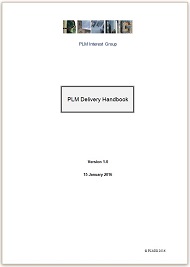|
PLM Interest Group |
||||||||||||||||||
|
|
|
|
||||||||||||||||
|
|
|
||||||||||||||||
|
|
|
|
||||||||||||||||
|
PLM Delivery Handbook
Overview
The PLM Delivery Handbook enables PLM user companies to work collaboratively with their suppliers to define targets for new implementation phases that both sides can commit to in writing.
The PLM Delivery methodology generates clear and accurate values for the proposed PLM Benefits; and then covers the processes of agreement and documentation with the Vendor. See the Handbook Table of Contents >>> Enhancing the Purchase Process
The fundamental premise in creating the Handbook is that users should get what they pay for when they implement PLM. This ought to be a natural outcome of the purchase process, but the proposal can seem more like a promise than a commitment. A corporate PLM spend can run into millions of dollars. Everyone will gain if it can clearly be shown that the spend is worthwhile. A good starting point is to understand how much PLM actually costs. Because there is no common knowledge about how much companies should spend on PLM, many user companies may be spending a lot more than they need to. When PLM under-performs there are many additional costs and overheads, either in hard cash or in lost productivity. Users start to believe that these are unavoidable. The method of calculating the figures now exists, by means of the PLM Justification methodology. This means that there is no more need for 'guesswork', and no need to abandon 'qualitative' metrics just because they seem too difficult to deal with. Devising new PLM projects can now be an exact science, rather than an act of faith. The PLM Delivery Handbook builds on this, with the first ever neutral methodology for users and vendors to collaborate on defining quantified delivery targets; and also addresses the business and contractual issues that must be overcome. Vendor Collaboration
A key feature of the PLM Delivery methodology is that the Vendor is much more closely involved in identifying and quantifying the PLM improvements that could be made. Not only does the Vendor participate in the early ideation and discovery activities, (thus adding to the breadth of ideas that are proposed); but the Vendor also stays involved during the calculation and planning. When the new proposal is submitted, the fact that both user and vendor have calculated the target benefits, and feel confident to endorse them in writing, is a major boost to gaining approval. Methodology
The methodology is structured around seven Steps:-
Detailed Calculation
When it comes to the detailed calculation of specific PLM Benefits, the PLM Delivery methodology is fully integrated with the PLM Justification Handbook and its associated toolset. This means that the PLM Delivery Handbook itself remains concise and easy to use at only 54 pages. Details
The PLM Delivery Handbook is available directly from the Store. Alternatively, the full PLM Delivery toolset is provided as part of PLMIG Membership. All documents are supplied in Word format so that users are able to modify and adapt them as desired, as specified in the Terms and Conditions. You can request more information about the Handbook, or about any other aspect of the initiative, via delivery@plmig.com. © Copyright 2025 PLM Interest Group |
|||||||||||||||||
| <<< Return Home | ||||||||||||||||||
|
|
|
|
||||||||||||||||





